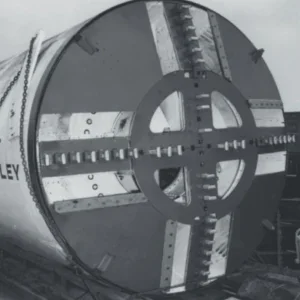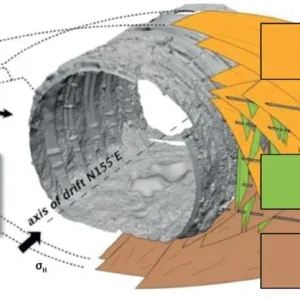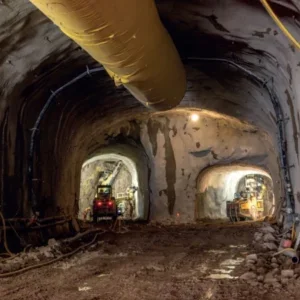
In 2016, global engineering consultancy Ramboll was appointed Category III Checker for Bam Nuttall, Morgan Sindall and Balfour Beatty Joint Venture (BMB JV) on the Tideway West section.
Tideway is the biggest infrastructure project undertaken by the UK water industry since it was privatised in 1989 (National Audit Office, 2017). It will be a 25km-long tunnel beneath London, spanning from Acton in the West to Abbey Mills Pumping Station in the East, and running for the most part beneath the River Thames. Its purpose is to increase the capacity of the existing Victorian sewerage system of Joseph Bazalgette to meet the demands of modern-day London. When completed, it will capture and control discharges into the River Thames from the most polluting Combined Sewer Overflows (CSOs) to meet EU and UK legislative requirements. The project was divided geographically into three different construction contracts: West, Central and East (Figure 1).
Ramboll has been responsible for undertaking the independent design checks and the provision of design assurances for a range of tunnels (segmentally lined, sprayed concrete lined (SCL), pipejacked); the associated works for shafts; and strengthening works for existing structures, including existing inlets and river walls along the Thames on the Tideway West contract. The Ramboll team have also provided support on both risk and the complex stakeholder management required resulting from the many interfaces and asset owners operating in the vicinity of Tideway.
DESIGN CHECKS
As checking has progressed, Ramboll has identified a clear benefit of progressive assurance, which has been implemented through working closely with the contractor, BMB, and client, Tideway. Traditionally, design checks have been undertaken on completed detailed design packages which can have a residual impact on programme and cost for a project, should issues be identified at this late stage of the design. As design changes have developed on Tideway, Ramboll has been present through the development of the solution, providing its expertise and knowledge to ensure a streamlined design programme. The adoption of early engagement of Category III checkers through concept and development design has been observed to be increasing within the tunnelling sector, with many clients and projects preferring this approach to limit risk and change.
Due to its successful engagement on Tideway, Ramboll has gone on to subsequently be appointed to undertake a full design and supervision role on a new portion of tunnelling works within the project.
In 2019, Ramboll was commissioned by BMB as designer, following a change event becoming necessary; this comprised the design and construction of a highly complex, 75m sprayed concrete lining (SCL) connection tunnel between the existing segmental tunnel and the CARRR deep shaft, following a TBM ‘turn and bury’ operation that had been carried out. This tunnel would act as the final link between the main tunnel across the whole contract.
The design comprises an 8.7m outer-diameter tunnel with a steel fibre-reinforced, sprayed-concrete primary lining; a cast-in-place steel bar- and steel fibre-reinforced concrete secondary lining; and a membrane which will be installed between primary and secondary linings to allow debonding and reduce restraint. Initially, a pilot tunnel of 6.1m outer diameter along the central axis will be constructed, followed by an enlargement using top heading and invert advances. The works will be within typical London geology, excavating through London Clay at a depth of 40m.
Dr Jiang Su, Technical Director at Ramboll and industry lead in SCL, explains: “With the industry increasingly adopting the use of SCL as the permanent primary lining, it has been key to understand the impact of the interface between the two linings on the performance of the secondary lining. At Ramboll, we have found it crucial to attain an excellent understanding of the behaviour of different types of interfaces which range from direct concrete-toconcrete contact, to sprayed and sheet waterproofing membranes.”
CONSTRAINTS
The project has several physical constraints due to the surrounding surface and subsurface assets and the proximity to the existing TBM tunnel. The alignment has been curved to avoid the TBM body and allow a breakthrough to the TBM tunnel segmental lining, while maintaining a minimum required distance of 20m away from an existing, almost perpendicular utilities tunnel.
As has been experienced time and time again in our industry, when a design change occurs during construction, the design must catch-up quickly. As such, and due to the construction of the connection tunnel being on the project critical path, the design, investigations and approvals period was significantly shorter than usual. Design development was required to progress from concept design to approved design over the space of eight months, and was further complicated in early 2019 with the onset of Covid-19 and the requirements for remote working.
To counter these setbacks, design coordination and collaboration on work packages was maintained between the different parties through online working and conference calls. Weekly workshops were held virtually between Ramboll, the contractor’s design and construction teams, and Tideway to discuss the design progress and critical interfaces.
COPING WITH COVID
Over the past 18 months, the industry has been forced inevitably to adapt to cope with the pandemic and continue design and construction. This has pushed our industry into a new age of digital collaboration and delivery, which at times has been slow to be implemented. The last year-and-a-half has seen the tunnelling sector pull together and implement remote working where necessary, as well as further health and safety precautions on site. This has paved the way for future projects to potentially be delivered remotely, in comparison to the traditional approach where designers and contractor/client teams are located under one roof. Going forward, this trend is likely to be seen more and more for project delivery.
COLLABORATION
An important aspect of the connection tunnel project has been the active engagement between design and construction teams, and end client, Tideway. The project team made an early decision to actively involve Tideway from the early stages, as well as throughout the workshop sessions, with the construction team developing the solutions. This working environment enabled ideas and solutions to flow efficiently, prompting innovation and creativity. One such example has been the development and undertaking of a full-scale trial of the connection detail between the SCL portion and the TBM segments to ensure the required quality is achieved. The final connection between the sprayed concrete-lined tunnel and the segmental tunnel involved the West section team breaking out the precast tunnel segments and forming an enlargement flare around the segmental interface ring.
Early engagement with the BMB construction team had identified the benefits of undertaking a full-scale trial to ensure the constructability of the design. Ramboll went on to specify the requirements of the trial and its success criteria, working with the BMB construction team which developed the methodology and logistics for the trial.
The construction trial was undertaken at surface level and intended to ensure constructability of the complex flare design and to help our sprayers familiarise themselves in advance of the in-situ works. A mock shutter was used to simulate the intended spraying sequence to be undertaken within the tunnel environment. The flare trial was successfully undertaken and helped achieve good quality SCL, warranting enough working space and ensuring integrity of the grout tube installations during spraying works.
Additionally, the collaborative approach has allowed for further innovation and sustainability benefits on Tideway, building on their commitment to take action to reduce climate change. This year has seen Ramboll officially launch its Climate Action Strategy, which is a key focus in our industry and sector as outlined by the UN Sustainable Development Goals (SDGs) and the Paris Agreement targets.
Richard Miller, Head of Tunnelling at Ramboll UK, says: “Ramboll’s Climate Action Plan strives to support our clients at any part of their net zero, climate-resilient journey and across the lifecycle of a project. Within Ramboll’s tunnelling team, we are continually challenging the brief to address the climate emergency and take action now to be part of the solution. Our team has a key interest in bringing digitalisation to the forefront to assist in developing practical solutions that will drive performance and add lasting value.”
A NEW MIX
On Tideway, Ramboll has supported client BMB in its pursuit to value engineer the original secondary lining concrete mix. Working in collaboration with the main tunnel designer, Ramboll helped develop a testing regime for a new mix which reduces the quantity of steel fibre from 40kg/m3 down to 35kg/m3. This has involved the undertaking of a large-scale beam-testing programme for verification of the new mix to understand its pre-crack and post-cracking behaviour, which is critical for sewerage tunnel durability design.
As designer of the connection tunnel, Ramboll worked with the main tunnel designer to back-analyse the beam test results and concluded that the new concrete mix performs at least as good as the old mix. The works have been carried out in conjunction with Tideway, which has subsequently approved the use of the new mix with the lower fibre content. Using the new concrete mix will save up to 230t of steel fibres for the 7km-long Tideway West main tunnel, bringing significant environmental and financial benefits.
Ramboll’s involvement on this project has culminated in providing on-site construction support throughout the construction phase of the connection tunnel. Ramboll’s designer site representatives have proactively supported the construction team to help ensure the smooth transition from paper to reality. Round the clock support has been provided during the complex interface connection between the SCL and TBM tunnel.
The collaboration throughout both the design and construction phases resulted in a design that was delivered to a tight programme. The SCL works are now complete ahead of schedule and the secondary lining works will be undertaken using the revised mix which will result in sustainable, commercial and performance improvements. July 2021 saw the breakthrough of the two tunnels, with works now underway to prepare for secondary lining works.







